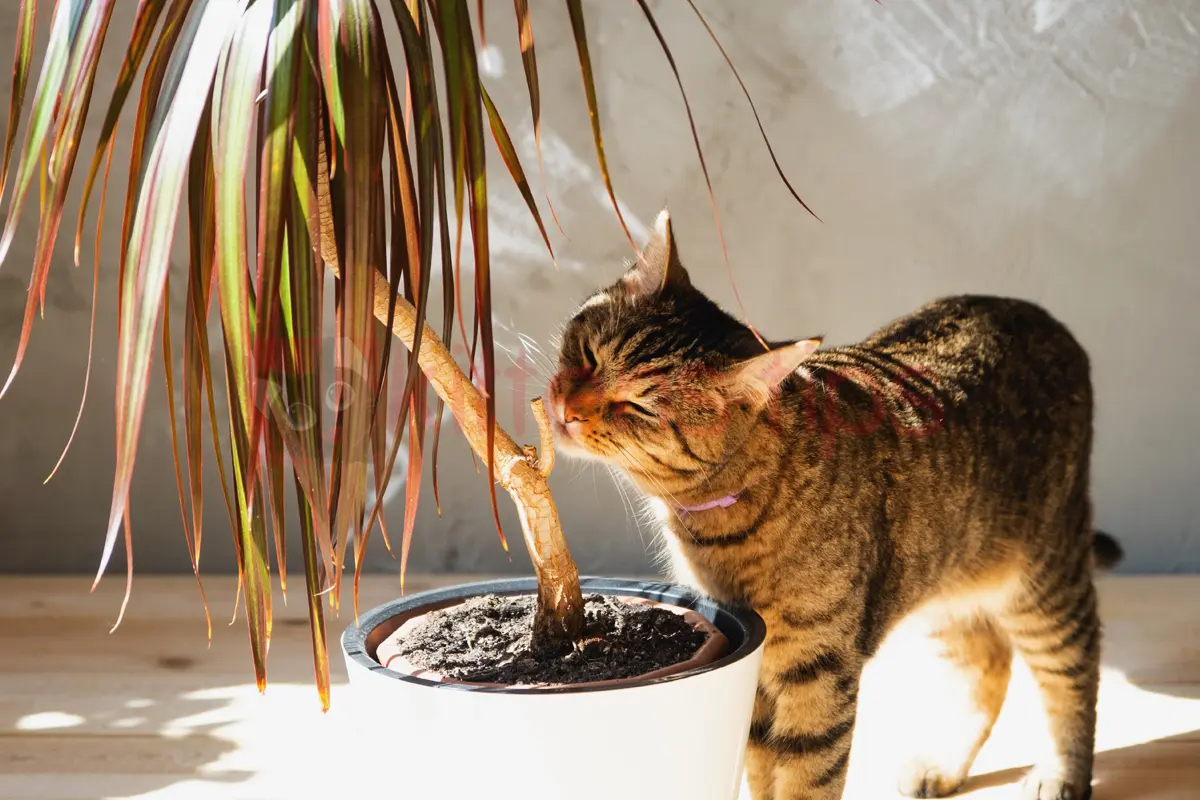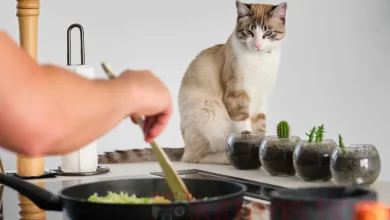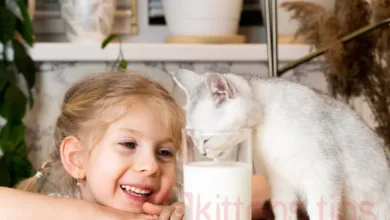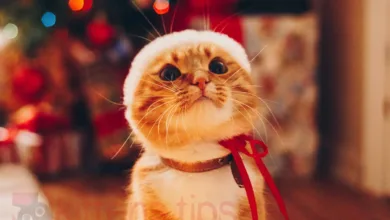
What are the toxic plants for cats (poisonous) and non-toxic plants?
If you’re a plant lover and have a cat at home, it is highly advisable to know what are the toxic plants for cats and the non-toxic ones.
To beautify the look of our homes, many of us choose to add color and a more natural atmosphere with the help of plants, not realizing that some of these can be poisonous to our feline friends and can endanger their lives.
Statistics show that there are over 700 toxic plants for cats and other pets or birds.
Despite being carnivorous animals, cats love to eat grass, especially during shedding, but also at other times, as it aids in digestion. Therefore, it’s crucial to know the toxic plants for cats. Folk wisdom suggests that they consume grass when they have a headache, but this is not confirmed by veterinarians or scientific studies.
Some cats refuse to consume plants and grass, but many will do so when they encounter potted plants in the house. These cats can confuse the plants with a treat and start nibbling on leaves, flowers, and even bulbs, unaware that it can harm them. Thus, it’s your responsibility to ensure their well-being and to educate yourself about the plants you can have around your cat. Knowing which plants are toxic for cats and which are non-toxic is essential when keeping them in your home.
Many of the toxic plants can cause skin inflammation, stomach issues, or oral cavity problems, while others can affect specific organs, putting the cat’s life in danger.
Table of Contents
List of toxic plants for cats (poisonous)
Aloe vera: depression, vomiting, diarrhea, anorexia, trembling, changes in urine color.
Azalea: excessive salivation, weakness, vomiting, diarrhea, hypotension, cardiac arrest.
Cardboard palm: intense thirst, jaundice, liver failure, intestinal bleeding, scratches, vomiting.
Begonia: vomiting, excessive meowing, swallowing difficulties, mouth irritations and burns.
Cactus: mouth and stomach irritations.
Calla Lily: vomiting, swallowing difficulties, mouth irritations and burns.
Lily and all related species: vomiting, diarrhea, kidney failure, lethargy, loss of appetite, salivation, trembling, seizures, cardiac arrhythmias, low blood pressure, abdominal pain, mouth irritations, swallowing difficulties. It is recommended not to have any lilies in the house, as they are fatal to many cats.
Christmas cactus: vomiting, stomach and mouth irritations.
Chrysanthemum: skin inflammation, excessive salivation, vomiting, diarrhea.
Cyclamen: salivation, heart rate irregularities, vomiting, diarrhea, cardio-respiratory arrest.
Dracaena: dilated pupils, blood in vomit, excessive salivation.
Ficus: skin inflammation, vomiting, salivation, mouth irritations.
Fern: abdominal pain, skin inflammation. (May cause these issues but is not toxic).
Philodendron: swallowing difficulties, vomiting, lip and tongue burns.
Carnation: skin irritations, gastrointestinal disorders.
Cucumbers: skin conditions, gastrointestinal problems.
Ivy: abdominal pain, excessive salivation, vomiting, diarrhea, mouth irritations, swallowing difficulties.
Lilies of the Valley: disorientation, low blood pressure, irregular heartbeats.
Tulip: vomiting, depression, diarrhea, excessive salivation.
Oleander: hypothermia, heart problems, gastrointestinal irritations.
Lilac: fainting, vomiting, kidney collapse, coma.
Daffodil: salivation, vomiting, diarrhea, hypotension, seizures.
Primrose: vomiting, diarrhea.
Tomato: gastrointestinal irritations, loss of appetite, weakness, low blood pressure, disorientation, slow pulse, dilated pupils, diarrhea.
Nettle: depression, anorexia, vomiting, diarrhea.
Elephant Ear: swallowing difficulties, vomiting, mouth irritations and burns.
Mistletoe: behavioral changes, hypotension, vomiting, cardiovascular failure, low pulse, diarrhea, gastrointestinal conditions.
Hyacinth: skin inflammation, allergic reactions, vomiting, diarrhea.
The list provided includes only the most common plants found in our homes, but it’s important to note that there are many more species of toxic plants for cats. Being aware of these toxic plants for cats is crucial for the safety of your feline friends, as ingestion or contact with these harmful botanicals can lead to a range of health issues and, in severe cases, even be life-threatening.
Symptoms – Cat Poisoned with Indoor or Garden Plants (Toxic Plants for Cats)
The symptoms that develop in a cat poisoned with plants can be associated with the organ affected by the poison, as follows:
If the kidneys are affected, the cat will consume excessive water and urinate frequently.
If the poison affects the mouth or esophagus, the cat will salivate profusely and have difficulty swallowing.
Vomiting and diarrhea occur when the stomach, colon, or intestines are affected.
An irregular, slow, or rapid heart rate is a sign that the heart is affected by the toxic substances the cat has ingested from the plant.
If you notice respiratory difficulties, the cat may have issues with the airways.
Also, if there are inflammations, redness, and itching, it may be due to exposure to a plant.
In all these cases, a visit to the veterinarian becomes a priority and is urgent. Take a leaf or a flower that the cat has consumed with you, or if it has already vomited, try to collect a sample. The treatment will be based on the plant species.
To make a correct diagnosis, the doctor will subject the cat to a thorough examination. They will take blood and urine samples, and if the poisoning is confirmed, they will administer substances to induce vomiting, medicinal charcoal to absorb any remaining toxic substances in the body after vomiting, and infusions of vitamins and minerals to support vital organs.
Even though you are prompt and treatment is administered immediately, many cats still succumb to poisoning. Doctors say that the most fatal plant for cats is the Easter Lily.
Recovery takes an extended period with special diets, so follow your veterinarian’s instructions and advice meticulously.
Read also: Toxic Essential Oils for Cats (Top 5 doTERRA)
Which Plants Are Non-Toxic for Cats
There are several non-toxic plants for cats that can serve as a safe alternative to potentially harmful ones. Here are a few examples of non-toxic plants for cats:
Catnip (Nepeta cataria) – A plant that attracts cats and provides them with a natural stimulant.
Parsley (Petroselinum crispum) – A seasoning you can grow in a pot that is safe for cats to consume.
Basil (Ocimum basilicum) – An aromatic plant that is non-toxic to cats.
Mint (Mentha) – A refreshing and stimulating plant for cats that is safe for them.
Rosemary (Rosmarinus officinalis) – A spice and aromatic plant that is not harmful to cats.
African Violet (Saintpaulia) – A popular indoor plant that is non-toxic to cats.
Fern (Nephrolepis exaltata) – An indoor plant with delicate leaves that is safe for cats.
Bamboo Palm (Chamaedorea seifrizii) – A small and elegant palm that poses no risks to cats.
Even though these plants are non-toxic, each cat may have individual reactions to different plants. Therefore, it’s always a good practice to monitor your cat’s behavior when introducing a new plant into your home and consult a veterinarian if you have any concerns about your cat’s safety in relation to specific plants.
Conclusion: toxic and non-toxic plants for cats
In conclusion, it is essential to be aware of toxic plants for cats and avoid them in our homes or gardens to ensure the safety of our feline friends. At the same time, there is a variety of non-toxic plants for cats that we can incorporate into their environment, providing them with natural stimulants and a richer living space. However, each cat may react differently to plants, so careful monitoring of their behavior and consultation with a veterinarian are always recommended when introducing new plants into our homes. The safety of our cats should always be a top priority.



